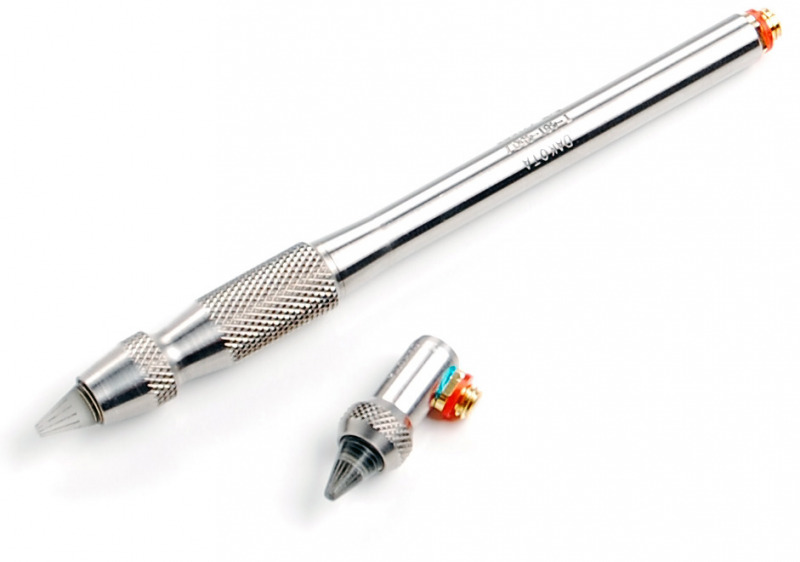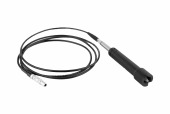Single Element Delay Line Pencil Transducers
High Precision and Accessibility for Specialised Applications
Dakota's single element delay line pencil transducers are essential tools for the accurate measurement of thicknesses in materials such as aluminum, titanium, steels, and thin plastics. These devices are optimised for use with the TI-PVX Ultrasonic Thickness Gauge and are ideal for testing in hard-to-reach areas or small-sized applications.
Key Features:
- Precise Focus Point: The sound beam is concentrated to a 1/16" spot, ideal for accurate measurements on containers, small diameter pipes, and turbine blades.
- Robust Construction: Each model is equipped with a 1/4" crystal and a microdot connector, designed to provide a secure connection and easy mounting.
- Ergonomic Design: Models offer different configurations such as top entry or right angle, facilitating use in various industrial applications.
Benefits of Dakota Pencil Transducers:
- Application Flexibility: Available in variants such as T-481-5507, T-681-4507, and T-581-5507, adapting to specific measurement needs.
- High-Resolution Measurements: Perfect for tasks that require high precision in thickness measurements and defect detection in materials.
- Adaptability to Various Materials: Acrylic and graphite delay tips allow effective measurements on different types of plastics, adjusting to the acoustic impedance of the measured material.
Important Note: Measurement ranges in plastics and other materials may vary depending on the model and type of delay tip used, providing flexibility and precision in use.
Contact us for more information or to place an order. We are ready to help you select the right Dakota transducer for your projects, ensuring accuracy and effectiveness in your ultrasonic measurements.
| Diameter | Frequency | Mode | Delay Tip | Range |
|---|---|---|---|---|
| 3/16" | 10 MHz | E-E | X-152-0000 | 0.006" - 0.300" ST |
| 3/16" | 10 MHz | I-E | X-152-0000 | 0.010" - 0.400" ST |
| 3/16" | 10 MHz | E-E | X-152-0000 | 0.005" - 0.300" PL |
| 3/16" | 10 MHz | I-E | X-152-0000 | 0.005" - 0.300" PL |
| 3/16" | 10 MHz | E-E | X-752-0000 | 0.006" - 0.300" ST |
| 3/16" | 10 MHz | I-E | X-752-0000 | 0.010" - 0.500" ST |
| 3/16" | 10 MHz | E-E | X-752-0000 | 0.005" - 0.400" PL |
| 3/16" | 10 MHz | I-E | X-752-0000 | 0.005" - 0.400" PL |
| 3/16" | 15 MHz | E-E | X-152-0000 | 0.006" - 0.100" ST |
| 3/16" | 15 MHz | I-E | X-152-0000 | 0.008" - 0.250" ST |
| 3/16" | 15 MHz | E-E | X-152-0000 | 0.005" - 0.150" PL |
| 3/16" | 15 MHz | I-E | X-152-0000 | 0.005" - 0.250" PL |
| 3/16" | 15 MHz | E-E | X-752-0000 | 0.006" - 0.150" ST |
| 3/16" | 15 MHz | I-E | X-752-0000 | 0.006" - 0.400" ST |
| 3/16" | 15 MHz | E-E | X-752-0000 | 0.005" - 0.100" PL |
| 3/16" | 15 MHz | I-E | X-752-0000 | 0.005" - 0.150" PL |
| Ranges were determined using standard 4340 steel calibration standards, and common plastic samples. These ranges may vary according to material type differences and surface conditions. | ||||
Accessories
PVX-V-BLOCK Transducer Holder for TI-PVX Thickness Gauge
- For better control and repeatability on flat and curved surfaces
- For TI-PVX pencil probes
More details
Buy Now
Availability: Available: 1 - 3 days, Delivery time: 1 - 3 weeks, special order request



